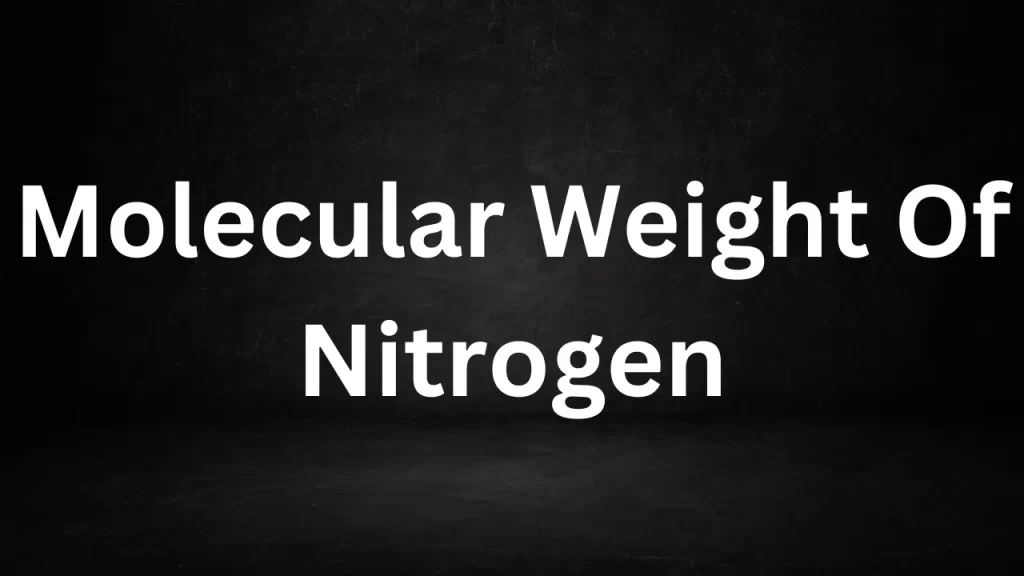Tag: nitrogen molecular mass
Molecular Mass Of N2
Molecular Mass Of N2: Molecular mass, also known as molecular weight, plays a crucial role in understanding the physical and chemical properties of substances.
It is a fundamental concept in chemistry, allowing us to quantify the mass of molecules and compounds. In this article, we will explore the mole mass of N2, or dinitrogen, and delve into why it’s a crucial component in the world of chemistry.

Molecular Mass Of N2
The Basics of Molecular Mass
Before we dive into N2’s molecular mass, let’s briefly review what molecular mass is and how it is calculated. Molecular mass represents the sum of the atomic masses of all the atoms in a molecule. This sum is typically expressed in atomic mass units (amu) or unified atomic mass units (u). To calculate the mole mass of a compound, you add up the atomic masses of all the atoms in the molecule based on the periodic table.
Understanding N2 (Dinitrogen)
N2, or dinitrogen, is the most abundant gas in Earth’s atmosphere, making up approximately 78% of the air we breathe. It consists of two nitrogen atoms (N) bonded together by a strong covalent bond. To determine the mole mass of N2, we need to consider the atomic masses of nitrogen atoms.
The atomic mass of nitrogen (N) is approximately 14.00674 amu. Since N2 contains two nitrogen atoms, we can calculate its mole mass as follows:
Molecular Mass of N2 = 2 × Atomic Mass of Nitrogen (N)
The Molecular Mass of N2 = 2 × 14.00674 amu
Molecular Mass of N2 ≈ 28.01348 amu
So, the mole mass of dinitrogen (N2) is approximately 28.01348 amu.
Significance of N2’s Molecular Mass
- Atmospheric Composition: Understanding the mole mass of N2 is crucial for comprehending the composition of Earth’s atmosphere. Nitrogen gas (N2) makes up the majority of the air, and its molecular mass helps scientists and meteorologists analyze the properties of the atmosphere, including its density and pressure.
- Chemical Reactions: Molecular mass is fundamental in chemical reactions. When chemists balance chemical equations, they take into account the molecular masses of reactants and products to ensure the conservation of mass. N2 participates in a wide range of chemical reactions, including those found in the Haber-Bosch process for ammonia production, as well as combustion reactions in engines and industrial processes.
- Avogadro’s Hypothesis: The mole mass of N2 plays a role in Avogadro’s hypothesis, which states that equal volumes of gases at the same temperature and pressure contain an equal number of molecules. N2 is frequently employed as a standard gas in gas stoichiometry owing to its abundance and precisely known molecular mass.
- Analytical Chemistry: In the field of analytical chemistry, the molecular mass of N2 finds application in methods such as mass spectrometry. It helps researchers identify and quantify unknown substances by comparing the molecular mass of their fragments to known values.
Conclusion
Understanding the mole mass of N2 (dinitrogen) is essential in various fields of science and industry. With a molecular mass of approximately 28.01348 amu, N2 plays a significant role in the composition of Earth’s atmosphere, chemical reactions, and analytical chemistry. This fundamental knowledge helps us better grasp the behavior of gases, the principles of stoichiometry, and the composition of the air we breathe. The mole mass of N2 serves as a cornerstone in the world of chemistry and is a vital concept for anyone studying the natural sciences.
Read More
- Molar Mass Of I
- Molecular Weight Of Cl
- Molecular Mass Of Sodium Carbonate
- Molecular Mass Of Nitric Acid
- Molecular Mass Of Sulphuric Acid
Frequently Asked Questions (FAQs) On Molecular Mass Of N2
1. What is N2, and why is it important to know its molecular mass?
N2, also known as dinitrogen, is a diatomic molecule composed of two nitrogen atoms bonded together. Its mole mass is essential to understand various aspects of chemistry, including chemical reactions, atmospheric composition, and analytical techniques.
2. What is the molecular mass of N2?
The mole mass of N2 is approximately 28.01348 atomic mass units (amu).
3. How is the molecular mass of N2 calculated?
To calculate the mole mass of N2, you add up the atomic masses of the two nitrogen (N) atoms in the molecule. Since the atomic mass of nitrogen is approximately 14.00674 amu, the mole mass of N2 is 2 times this value.
4. Why is N2’s molecular mass important in the field of chemistry?
N2’s molecular mass is crucial because it is involved in various chemical reactions, serves as a reference gas in gas stoichiometry, and plays a role in Avogadro’s hypothesis, which is fundamental in understanding the behavior of gases.
5. How does N2 contribute to Earth’s atmosphere?
N2 is the most abundant gas in Earth’s atmosphere, making up approximately 78% of the air we breathe. Its molecular mass influences the density and pressure of the atmosphere, affecting weather patterns and other atmospheric processes.
Molecular Weight Of N2
Molecular Weight Of N2: Nitrogen gas, often represented as N2, is one of the most abundant gases in Earth’s atmosphere, making up approximately 78% of the air we breathe. In the realm of chemistry, understanding the molecular weight of nitrogen gas is fundamental.
This article will delve into the concept of molecular weight, explain how it relates to nitrogen gas (N2), and discuss the significance of this knowledge in various scientific and industrial applications.

Molecular Weight Of N2
Molecular Weight: A Fundamental Concept
The Molecular weight, also known as molar mass, is a critical concept in chemistry. It represents the mass of one mole of a specific substance and is typically expressed in grams per mole (g/mol). A mole is a unit used to quantify the amount of a substance and contains approximately 6.022 x 10^23 entities, known as Avogadro’s number. The molecular weight is numerically equivalent to the atomic or molecular weight of the substance.
The Molecular Weight of Nitrogen Gas (N2)
Nitrogen gas (N2) consists of two nitrogen atoms bonded together. To calculate the molecular weight of nitrogen gas, we consider the atomic masses of nitrogen atoms.
- The atomic mass of a single nitrogen (N) atom is approximately 14.01 g/mol.
- Since nitrogen gas (N2) consists of two nitrogen atoms, its molecular weight is calculated as follows:
- Molecular Weight of Nitrogen Gas (N2) = 2 x Atomic Mass of N ≈ 2 x 14.01 g/mol ≈ 28.02 g/mol
Significance of Molecular Weight of Nitrogen Gas
Understanding the molecular weight of nitrogen gas is essential due to its relevance in various fields:
1. Chemistry and Chemical Reactions:
The molecular weight of nitrogen gas plays a pivotal role in chemical reactions that incorporate nitrogen compounds. It aids in stoichiometry, allowing chemists to balance equations and determine the quantities of nitrogen gas required or produced.
2. Industrial Applications:
Nitrogen gas sees extensive use in various industries, including food packaging, electronics manufacturing, and metal processing. Knowledge of its molecular weight is vital for precise handling and storage.
3. Environmental Sciences:
In environmental studies, the molecular weight of nitrogen gas is relevant when analyzing air composition and assessing air quality, particularly in the context of pollution and emissions.
4. Agriculture:
Nitrogen is a vital nutrient for plant growth. Understanding the molecular weight of nitrogen gas is essential for calculating nitrogen content in fertilizers and optimizing agricultural practices.
5. Healthcare and Medicine:
Nitrogen gas finds applications in the medical field, such as in cryopreservation and as an inert gas during surgical procedures. Knowledge of its molecular weight is important for medical gas formulations.
6. Space Exploration:
In the realm of space exploration, the molecular weight of nitrogen gas plays a significant role in designing life support systems and assessing atmospheric compositions on distant planets and celestial bodies.
Conclusion
The molecular weight of nitrogen gas (N2) is a fundamental concept in chemistry with broad applications across scientific disciplines and industries. It facilitates precise calculations, contributes to industrial processes, and plays a vital role in fields ranging from agriculture and environmental sciences to healthcare and space exploration. By comprehending the molecular weight of nitrogen gas, scientists, chemists, and professionals can make informed decisions and contributions to various fields, ultimately benefiting society and advancing our understanding of the natural world and beyond.
Read More
- Molecular Weight Of Potassium
- Molecular Weight Of O2
- Calcium Carbonate Molar Mass
- Molar Mass Of Ammonia
- Molecular Mass Of Acetic Acid
Frequently Asked Questions (FAQs) On Molecular Weight Of N2
1. What is the molecular weight of nitrogen gas (N2)?
The molecular weight of nitrogen gas (N2) is approximately 28.02 grams per mole (g/mol). This value is based on the atomic masses of nitrogen atoms (N) within the N2 molecule.
2. Why is the molecular weight of nitrogen gas important in chemistry?
The molecular weight of nitrogen gas is crucial in chemistry because it helps determine the quantities of nitrogen gas involved in chemical reactions and allows for accurate stoichiometric calculations.
3. How is the molecular weight of nitrogen gas (N2) calculated?
The molecular weight of nitrogen gas is calculated by adding the atomic masses of the two nitrogen atoms (N) within the N2 molecule. The atomic mass of nitrogen is approximately 14.01 g/mol.
4. What is the significance of the molecular weight of nitrogen gas in industrial applications?
Nitrogen gas is used in various industrial processes, and its molecular weight is essential for precise handling, storage, and calculations in applications such as food packaging, electronics manufacturing, and metal processing.
5. How does the molecular weight of nitrogen gas relate to environmental sciences?
In environmental studies, the molecular weight of nitrogen gas is relevant for analyzing air composition and assessing air quality, particularly when evaluating nitrogen oxide emissions and atmospheric pollution.
Molecular Weight Of Nitrogen
Molecular Weight Of Nitrogen: Nitrogen, a fundamental element found abundantly in our planet’s atmosphere, plays a pivotal role in various aspects of science and industry.
Its molecular weight, a key property, provides valuable insights into its behavior and applications. In this article, we’ll explore the molecular weight of nitrogen and its significance in diverse fields.

Molecular Weight Of Nitrogen:
Molecular Weight: A Fundamental Concept
Before delving into nitrogen’s molecular weight, let’s grasp the concept itself. Molecular weight, also known as molar mass, signifies the sum of the atomic weights of all the atoms present in a molecule. This numerical value is usually expressed in atomic mass units (amu) or grams per mole (g/mol). Molecular weight serves as a foundational parameter in chemical calculations, enabling scientists to understand the properties and interactions of substances at the molecular level.
Calculating the Molecular Weight of Nitrogen
Nitrogen primarily exists as a diatomic molecule in its natural state, with two nitrogen atoms bonded together as N2. To determine its molecular weight, we simply add the atomic weights of these constituent atoms. The atomic weight of a single nitrogen atom (N) is approximately 14.00674 amu. As nitrogen exists as N2, we multiply this value by 2 to obtain the molecular weights:
Molecular Weight of Nitrogen (N2) = 2 × Atomic Weight of Nitrogen (N)
Molecular Weight of Nitrogen (N2) = 2 × 14.00674 amu ≈ 28.01348 amu
Therefore, the molecular weights of nitrogen, when it exists as N2, is approximately 28.01348 amu or 28.01348 g/mol.
Implications of Nitrogen’s Molecular Weight
Understanding the molecular weights of nitrogen is essential for comprehending its behavior and applications:
- Gas Properties: Nitrogen, with a molecular weight close to 28 g/mol, is lighter than many other gases in the atmosphere, making up about 78% of the air we breathe. Its relatively low molecular weight allows it to remain close to the Earth’s surface, playing a vital role in sustaining life.
- Chemical Reactivity: Nitrogen’s molecular weight influences its chemical reactivity. As N2, it possesses a robust and stable triple bond between its nitrogen atoms, making it unreactive under normal conditions. This stability is critical for maintaining the composition of Earth’s atmosphere.
- Industrial Applications: Nitrogen’s low molecular weight and inert nature have led to various industrial applications, including its use in food packaging, preventing oxidation in electronics manufacturing, and as a key component in ammonia production for fertilizers.
- Biological Significance: In biology, nitrogen’s molecular weight is pivotal. It determines the mass of nitrogen-containing biomolecules such as proteins and nucleic acids (DNA and RNA). Understanding nitrogen’s molecular weight aids in quantifying and analyzing these essential biomolecules, which are fundamental to life.
Conclusion
The molecular weight of nitrogen, approximately 28.01348 g/mol when existing as N2, is a critical parameter that influences its behavior and applications in numerous fields.
Read More
- Molecular Weight Of NaOH
- Difference Between Force And Pressure
- Difference Between Diode And Rectifier
- Difference Between AM And FM
- Dielectric Material And Dipole Moment
Frequently Asked Question (FAQs) Molecular Weight Of Nitrogen
-
What is the molecular weight of nitrogen?
The molecular weights of nitrogen, when it exists as a diatomic molecule (N2), is approximately 28.01348 atomic mass units (amu) or 28.01348 grams per mole (g/mol).
-
Why is nitrogen’s molecular weight important?
Nitrogen’s molecular weight is crucial because it influences its behavior as a gas, its chemical reactivity, and its significance in various fields, including biology, industry, and environmental science. Understanding its molecular weight helps scientists and researchers make informed decisions about its use and applications.
-
How is nitrogen’s molecular weight calculated?
To calculate the molecular weights of nitrogen (N2), you sum the atomic weights of the constituent atoms, which are two nitrogen (N) atoms. The atomic weights of a single nitrogen atom is approximately 14.00674 amu. Therefore, the molecular weights of N2 is 2 times the atomic weights of nitrogen.
-
What are the main properties of nitrogen related to its molecular weight?
Nitrogen’s relatively low molecular weight compared to other atmospheric gases makes it lighter, allowing it to stay close to the Earth’s surface. Its stable diatomic form (N2) with a strong triple bond makes it unreactive under normal conditions, contributing to the stability of the Earth’s atmosphere.
-
In what industries is nitrogen commonly used?
Nitrogen has diverse industrial applications. It is used in the food industry for packaging and preservation, in electronics manufacturing to prevent oxidation, and in the production of ammonia for fertilizers, among others. Its inert nature and low molecular weight make it valuable in various processes.